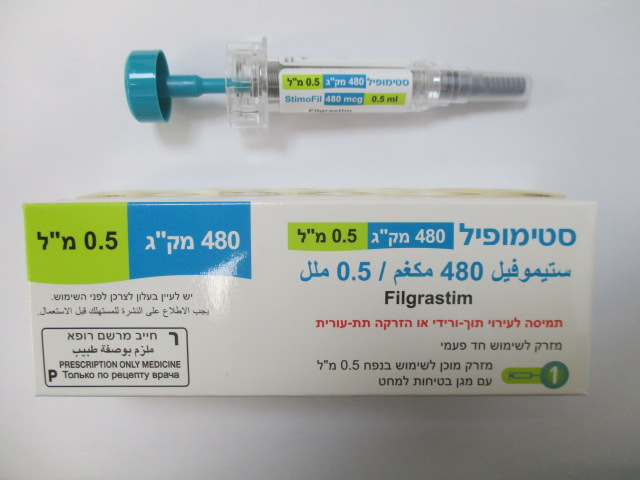Quest for the right Drug

סטימופיל 480 מק"ג/0.5 מ"ל STIMOFIL 480 MCG/0.5 ML (FILGRASTIM)
תרופה במרשם
תרופה בסל
נרקוטיקה
ציטוטוקסיקה
צורת מתן:
תת-עורי, תוך-ורידי : S.C, I.V
צורת מינון:
תמיסה להזרקהאינפוזיה : SOLUTION FOR INJECTION / INFUSION
עלון לרופא
מינוניםPosology התוויות
Indications תופעות לוואי
Adverse reactions התוויות נגד
Contraindications אינטראקציות
Interactions מינון יתר
Overdose הריון/הנקה
Pregnancy & Lactation אוכלוסיות מיוחדות
Special populations תכונות פרמקולוגיות
Pharmacological properties מידע רוקחי
Pharmaceutical particulars אזהרת שימוש
Special Warning עלון לרופא
Physicians Leaflet
Pharmacological properties : תכונות פרמקולוגיות
Pharmacodynamic Properties
5.1 Pharmacodynamic properties Pharmacotherapeutic group: immunostimulants, colony stimulating factors, ATC code: L03AA02 Pharmacodynamic effects Human G-CSF is a glycoprotein which regulates the production and release of functional neutrophils from the bone marrow. StimoFil containing r-metHuG-CSF (filgrastim) causes marked increases in peripheral blood neutrophil counts within 24 hours, with minor increases in monocytes. In some SCN patients, filgrastim can also induce a minor increase in the number of circulating eosinophils and basophils relative to baseline; some of these patients may present with eosinophilia or basophilia already prior to treatment. Elevations of neutrophil counts are dose-dependent at recommended doses. Neutrophils produced in response to filgrastim show normal or enhanced function as demonstrated by tests of chemotactic and phagocytic function. Following termination of filgrastim therapy, circulating neutrophil counts decrease by 50% within 1 to 2 days, and to normal levels within 1 to 7 days. Use of filgrastim in patients undergoing cytotoxic chemotherapy leads to significant reductions in the incidence, severity and duration of neutropenia and febrile neutropenia. Treatment with filgrastim significantly reduces the duration of febrile neutropenia, antibiotic use and hospitalization after induction chemotherapy for acute myelogenous leukemia or myeloablative therapy followed by bone marrow transplantation. The incidence of fever and documented infections were not reduced in either setting. The duration of fever was not reduced in patients undergoing myeloablative therapy followed by bone marrow transplantation. Use of filgrastim, either alone, or after chemotherapy, mobilizes hematopoietic progenitor cells into the peripheral blood. These autologous PBPCs may be harvested and infused after high-dose cytotoxic therapy, either in place of, or in addition to bone marrow transplantation. Infusion of PBPCs accelerates hematopoietic recovery reducing the duration of risk for haemorrhagic complications and the need for platelet transfusions. Recipients of allogeneic PBPCs mobilized with filgrastim experienced significantly more rapid hematological recovery, leading to a significant decrease in time to unsupported platelet recovery when compared with allogeneic bone marrow transplantation. One retrospective European study evaluating the use of G-CSF after allogeneic bone marrow transplantation in patients with acute leukemias suggested an increase in the risk of GvHD, treatment related mortality (TRM) and mortality when G-CSF was administered. In a separate retrospective international study in patients with acute and chronic myelogenous leukemias, no effect on the risk of GvHD, TRM and mortality was seen. A meta-analysis of allogeneic transplant studies, including the results of nine prospective randomized trials, 8 retrospective studies and 1 case-controlled study, did not detect an effect on the risks of acute GvHD, chronic GvHD or early treatment-related mortality. Relative risk (95% CI) of GvHD and TRM following treatment with G-CSF after bone marrow (BM) transplantation Publication Period of N Acute Grade Chronic TRM Study II - IV GvHD GvHD a Meta-Analysis 1986 - 2001 1198 1.08 1.02 0.70 (2003) (0.87, 1.33) (0.82, 1.26) (0.38, 1.31) b European Retrospective 1992 - 2002 1789 1.33 1.29 1.73 Study (2004) (1.08, 1.64) (1.02, 1.61) (1.30, 2.32) b International Retrospective 1995 - 2000 2110 1.11 1.10 1.26 Study (2006) (0.86, 1.42) (0.86, 1.39) (0.95, 1.67) a Analysis includes studies involving BM transplant during this period; some studies used GM-CSF b Analysis includes patients receiving BM transplant during this period Use of filgrastim for the mobilization of PBPCs in normal donors prior to allogeneic PBPC transplantation In normal donors, a 10 µg/kg/day dose administered subcutaneously for 4 - 5 consecutive days allows a collection of ≥ 4 x 106 CD34+ cells/kg recipient body weight in the majority of the donors after two leukaphereses. Use of filgrastim in patients, children or adults, with SCN (severe congenital, cyclic, and idiopathic neutropenia) induces a sustained increase in absolute neutrophil counts in peripheral blood and a reduction of infection and related events. Use of filgrastim in patients with HIV infection maintains normal neutrophil counts to allow scheduled dosing of antiviral and/or other myelosuppressive medication. There is no evidence that patients with HIV infection treated with filgrastim show an increase in HIV replication. As with other hematopoietic growth factors, G-CSF has shown in vitro stimulating properties on human endothelial cells.
Pharmacokinetic Properties
5.2 Pharmacokinetic properties Absorption Following subcutaneous administration of recommended doses, serum concentrations were maintained above 10 ng/ml for 8 - 16 hours. Distribution The volume of distribution in blood is approximately 150 ml/kg. Elimination Clearance of filgrastim has been shown to follow first-order pharmacokinetics after both subcutaneous and intravenous administration. The serum elimination half-life of filgrastim is approximately 3.5 hours, with a clearance rate of approximately 0.6 ml/min/kg. Continuous infusion with StimoFil over a period of up to 28 days, in patients recovering from autologous bone-marrow transplantation, resulted in no evidence of drug accumulation and comparable half-lives. Linearity There is a positive linear correlation between the dose and the serum concentration of filgrastim, whether administered intravenously or subcutaneously.

מסגרת הכללה בסל
התוויות הכלולות במסגרת הסל
| התוויה | תאריך הכללה | תחום קליני | Class Effect | מצב מחלה |
|---|---|---|---|---|
| הפחתת משך וחומרה של נויטרופניה בחולים העוברים השתלת מח עצם או המטופלים בכימוטרפיה המדכאת את מח העצם. | 01/01/1995 | LIPEGFILGRASTIM, FILGRASTIM, PEGFILGRASTIM, LENOGRASTIM | ||
| טיפול לצורך העלאת הספירה הנויטרופילית והפחתת זיהומים בילדים ומבוגרים הסובלים מנויטרופניה מולדת חמורה, נויטרופניה ציקלית או נויטרופניה אידיופאתית ושסבלו מזיהומים משמעותיים מבחינה קלינית ומ-3 אירועים של נויטרופניה בשנה האחרונה. | 01/01/1995 | LIPEGFILGRASTIM, FILGRASTIM, PEGFILGRASTIM, LENOGRASTIM | ||
| טיפול בנויטרופניה כרונית חמורה. | 01/01/1995 | LIPEGFILGRASTIM, FILGRASTIM, PEGFILGRASTIM, LENOGRASTIM |
שימוש לפי פנקס קופ''ח כללית 1994
לא צוין
תאריך הכללה מקורי בסל
לא צוין
הגבלות
לא צוין
מידע נוסף
